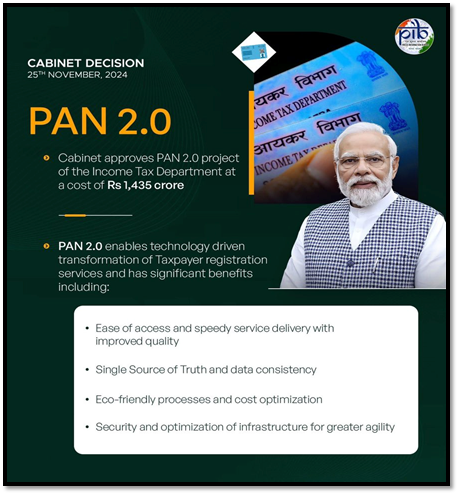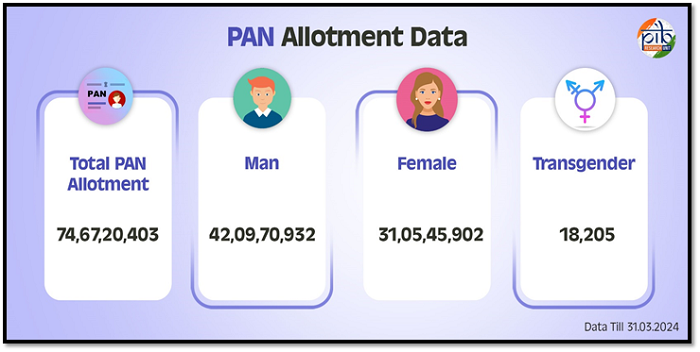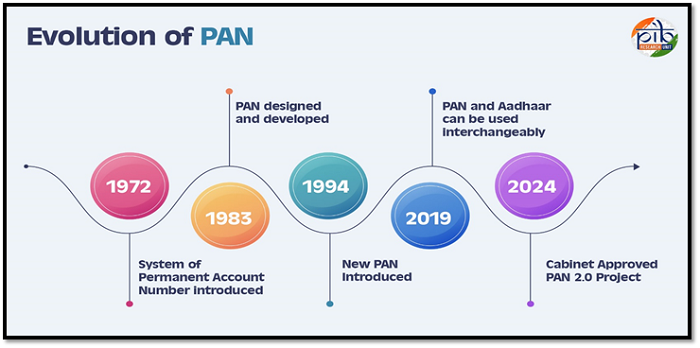The Permanent Account Number (PAN) has long been a cornerstone of India's financial and administrative systems, connecting individuals and businesses to vital economic activities while promoting financial transparency and compliance. As a key enabler of the digital economy, PAN has transformed into a gateway for essential services, making it indispensable in daily life. To enhance user-friendliness and align with technological advancements, the Cabinet has recently approved PAN 2.0, a step forward in redefining how PAN serves India's evolving digital and financial landscape.

PAN 2.0: A Landmark in Financial Innovation

The PAN 2.0 Project is a transformative initiative to modernise taxpayer registration through advanced e-governance. With a financial outlay of ₹1,435 crore, it re-engineers the PAN/TAN services to offer seamless digital experiences. This project aims to streamline and modernise the process of issuing and managing PAN and TAN, making it more user-friendly and efficient. The project addresses the requirements of taxpayers, focusing on consolidation of multiple platforms/portals and efficient services to PAN/ TAN holders.
PAN 2.0 Project enables technology-driven transformation of Taxpayer registration services and has significant benefits including:
- A single portal for all PAN/TAN-related services to simplify access for users.
- Eco-friendly paperless less processes to reduce paperwork.
- PAN will be issued free of cost, with quicker processing times.
- Personal and demographic data will be protected through enhanced security measures, including a PAN Data Vault.
- A dedicated call centre and helpdesk to address user queries and issues.

PAN 2.0 Revolutionizing Existing System
PAN 2.0 aims to revolutionize the existing system by integrating all PAN/TAN services into a unified portal, ensuring a seamless and paperless process. Free e-PAN services and simplified updates enhance convenience for taxpayers. Have a look at these key features in detail: -
- Integration of Platforms: PAN-related services are currently hosted on three different portals (e-Filing Portal, UTIITSL Portal and Protean e-Gov Portal). In the PAN 2.0 Project, all PAN/TAN-related services will be hosted on a single unified portal of the Income Tax Department. The said Portal would host all end-to-end services related to PAN and TAN like allotment, updation, correction, Online PAN Validation (OPV), Know your AO, AADHAAR-PAN linking, verify your PAN, request for e-PAN, request for re-print of PAN card etc.
- Comprehensive use of technology for paperless processes: Complete the online paperless process as against the prevailing mode.
- Taxpayer facilitation: Allotment/updation/correction of PAN will be done free of cost, and e-PAN will be sent to the registered mail ID. For a physical PAN card, the applicant has to request along with the prescribed fee of Rs 50 (domestic). For delivery of the card outside India, Rs. 15 + India post charges at actuals will be charged to the applicant.
Changes for Existing PAN Cardholders
Old PAN cardholders need not worry—existing PAN cardholders are not required to apply for a new PAN under the upgraded system. The current valid PAN cards will remain fully operational under PAN 2.0 unless holders request an update or correction. No new PAN card will be issued unless a specific request for updates or corrections is made.
QR Code Feature in PAN 2.0
A look at the QR code feature and what’s changing under PAN 2.0:
- The QR code is not new; it has been part of PAN cards since 2017-18. Under PAN 2.0, it will be enhanced with a dynamic QR code displaying the latest data from the PAN database.
- PAN holders with older cards lacking a QR code can apply for a new card with a QR code under both the current PAN 1.0 system and the upgraded PAN 2.0.
- The QR code facilitates validation of PAN details, ensuring authenticity.
- A dedicated QR reader application is available to verify details. When scanned, it displays the holder's photo, signature, name, parents’ names, and date of birth.
Global Standards for Secure and Seamless Services
The PAN 2.0 Project adopts global standards to enhance taxpayer registration with seamless digital processes and strong data security. It ensures compliance with key ISO certifications for quality, security, and service management (e.g., ISO 27001, ISO 9001). The project streamlines PAN/TAN registration with simplified online processes, minimal documentation, and centralized databases, improving user experience while safeguarding data through robust security and international best practices.
PAN Service in India[1]
PAN 2.0 builds upon decades of evolution since the introduction of the Permanent Account Number (PAN) in 1972. Designed as a unique 10-digit alphanumeric identifier, PAN links an individual or entity's financial transactions, such as tax payments, TDS/TCS credits, and income returns, to the Income Tax Department. By streamlining and modernizing these processes, PAN 2.0 aims to enhance efficiency, security, and ease of access, ensuring a robust digital framework that simplifies compliance and strengthens financial transparency.
PAN is to be obtained by
- Every person if his total income or the total income of any other person in respect of which he is assessable during the year exceeds the maximum amount which is not chargeable to tax.
- A charitable trust who is required to furnish return under Section 139(4A)
- Every person who is carrying on any business or profession whose total sales, turnover, or gross receipts are or is likely to exceed five lakh rupees in any year
- Every person who intends to enter into specified financial transactions in which quoting of PAN is mandatory.
- Every non-individual resident person and person associated with them shall apply for PAN if the financial transaction entered into by them during the financial year exceeds Rs. 2,50,000.
Penalty for not having PAN or having more than one PAN
- Section 272B of the Income-tax Act imposes a penalty of Rs. 10,000 for taxpayers who fail to comply with PAN-related provisions. This includes not obtaining a PAN when required, knowingly quoting an incorrect PAN on prescribed documents, or providing an incorrect PAN to the person deducting or collecting tax.
- As per the Income-tax Act, no individual is allowed to hold more than one PAN. If a person does hold multiple PANs, they must inform the Jurisdictional Assessing Officer and request the additional PAN to be deactivated or deleted.
- Under PAN 2.0, the system has been enhanced with improved logic to identify duplicate PAN requests. This centralized and advanced mechanism will help minimize instances of individuals holding more than one PAN.
TAN Allotment[2]
TAN (Tax Deduction and Collection Account Number) is a 10-digit alphanumeric code issued by the Income Tax Department for entities responsible for TDS/TCS. It is mandatory for filing returns, making payments, and issuing TDS/TCS certificates. TAN cannot be replaced with PAN except under specific provisions like Section 194-IA. Failure to obtain or quote TAN can lead to penalties, emphasizing its critical role in ensuring compliance with tax regulations and accurate deduction tracking.
Conclusion
The PAN 2.0 Project marks a significant leap towards modernizing India's tax system with enhanced digital processes, security, and greater accessibility. By shifting to a Direct Delivery Model and integrating global best practices, it promises a more streamlined and efficient experience for taxpayers, aligning with the government’s vision of a digital India. This initiative not only simplifies services but also ensures data security and transparency, fostering better tax compliance and governance.







 CAclubindia
CAclubindia

